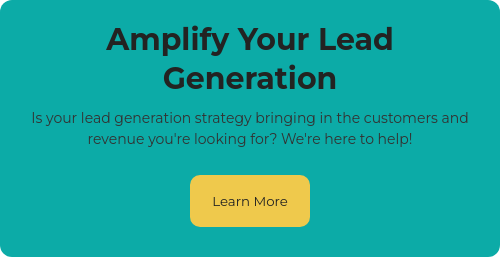Generating leads is challenging but essential for the survival of your brand. In fact, lead gen is the top priority of marketers. But generating leads for your brand isn’t a straightforward process since it requires strategy development, execution, and evaluation, and continuous optimization for improvement.
So, how do you go about tackling such an important part of your marketing objectives?
This step-by-step guide will show you how you can create and execute a successful lead gen strategy for your brand, starting today.
Step #1: Set Objectives
Lead gen strategy development begins with setting clear goals and objectives. What exactly do you want to achieve for your brand with a lead generation strategy? How many leads your brand needs per month or year?
Setting clear goals makes it easier to track progress, monitor, and evaluate your strategy at timely intervals. You and your team know where you have to go and how to get there.
The goals for your lead generation marketing must be SMART. A SMART goal is:
-
Specific
-
Measurable
-
Achievable/attainable
-
Relevant
-
Timely/time-bound
Here’s an example of a SMART goal: Generate 50,000 leads in 12 months from organic traffic.
It is a specific goal that shows what your brand wants to achieve in the 12 months. Leads generated from organic traffic can be measured, so it is a measurable goal. It is achievable (though it mostly depends on the historical data you have) but generally, generating 50K leads a year isn’t a big task. This goal is also relevant to your brand requirements since generating leads is what your brand needs. Finally, it has a time limit attached to it (12 months).
You can create one, two, or more SMART lead generation goals depending on your brand strategy, marketing budget, and other variables.
Step #2: Create Buyer Personas
Who is your target audience? Who is your ideal customer?
Having a clear understanding of your target audience will help you generate leads that will convert to loyal customers. When you know your target audience, you'll be able to connect with the right people at the right touchpoints via the right content.
For example, if your target audience prefers watching video content more than reading a blog post, you'll have to use video marketing as your lead generation strategy to reach and connect with your audience.
This is where buyer personas can help. A buyer persona is a semi-fictional representation of your ideal customer. You need data to create buyer personas that truly represent your ideal customers. Here is how it looks:
The more detailed it is, the better. It provides you all the details about your target audience and the best marketing channel to reach them for lead gen.
Step #3: Create Lead Magnets
Lead magnets are the backbone of the lead generation. A lead magnet is an incentive that you offer to your audience in exchange for their email addresses. It helps you generate leads. This lead magnet generated 35,859 leads in 60 days:

Nothing fancy, the lead magnet offers high-quality content to the audience at no cost in exchange for their email addresses.
You need to create several types of lead magnets for your target audience. Give them something valuable free of cost. Solve their biggest problem via a lead magnet. Again, what your audience considers valuable and high quality varies greatly, and the best way to know it is via buyer personas.
Use buyer personas and research to find what type of lead magnets will convert best. Here are a few lead magnet types that you can create:
-
Cheat sheets
-
Templates
-
Guides
-
Case studies
-
Training and courses
-
Reports
-
Free trials, discounts, and coupons
Step #4: Landing Pages
One of the most important things for your lead gen strategy is landing pages. This is the page where you can offer the lead magnet to your ideal customers. Preferably, you'll create at least one landing page per lead magnet.
However, when it comes to landing pages, more is better.
The number of landing pages has a positive association with lead generation. Brands that create 40+ landing pages generate way more leads than brands with fewer landing pages:
Creating multiple landing pages per lead magnet will help you generate more leads as it will provide your audience with more conversion options.
Creating high-converting landing pages gets easier if you are using a landing page creation tool. The top landing page creator tools include:
Step #5: Drive Traffic
This is the tough part.
You have the landing pages set up and ready, now it’s time to send traffic to your landing pages. There isn’t any right or wrong traffic generation method; rather, it comes down to your lead generation strategy objectives.
The traffic source should align with the lead gen strategy objectives. If your objective is to generate leads with PPC, you need to identify ad networks at this stage based on data, budget, and brand strategy.
If it's organic traffic, you'll need to create blog posts, build links, rank for keywords, repurpose content, distribute content, and more.
An important aspect of driving traffic to your landing pages for lead generation is that the traffic source must originate from the buyer persona you are targeting. Look at the preferences and interests of the buyer persona you are targeting and make sure the traffic source and content type you are using is the preference of the buyer persona.
Otherwise, it will fail badly.
Integration among lead gen strategy objectives, traffic source, content type, and buyer persona is a must.
Step #6: Lead Scoring and Nurturing
Once you start generating leads, you have two major things to do: score and nurture leads.
Lead scoring helps you order and prioritize leads based on their likelihood of buying. The leads can be scored based on several factors such as sale amount, purchase readiness, expected lifetime value, etc.
Not all leads are sales-ready, so you have to connect, engaged, and work on the leads that aren’t ready yet. This is what you achieve with the help of lead nurturing. Both scoring and nurturing run simultaneously for enhanced effectiveness.
You can use different tools to score and nurture leads; for example, CRM, email marketing, funnel management, marketing automation, etc. are the types of tools that you can use. However, the best approach is to use an effective CRM tool (e.g., Salesforce or HubSpot) as it will help you throughout the buyer journey.
Step #7: Analyze and Tweak
Conversion Rate Optimization (CRO) is an important part of your lead generation strategy execution. You need to test and tweak everything for improvement. This includes testing lead magnets, optimizing landing pages, improving conversion rates of different marketing channels, and more.
Your lead generation strategy requires regular tweaks. You can’t set it and forget it. That’s not how it works.
You need to compare progress based on the objectives and set targets. Look for loopholes and issues. If things aren’t moving as expected, see what you are doing wrong.
If things are moving as expected, figure out how you can improve it further. There is always room for improvement.
You'll need a CRO and A/B testing tool (e.g., Google Optimize or VWO). Run data-driven experiments to optimize the conversion rate.
Conclusion
Creating and executing a successful lead gen strategy gets easier if you know the ins and outs. If you are just starting, you might face a lot of hurdles. Getting help from a lead generation agency like First Page Strategy can help you save resources and get everything set up quickly. Our lead generation services will connect you with the experts needed to take the right steps for a successful lead generation strategy.









